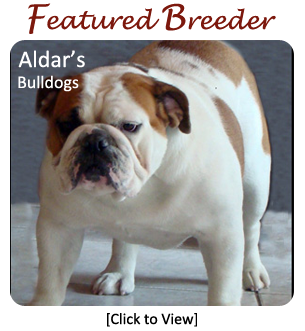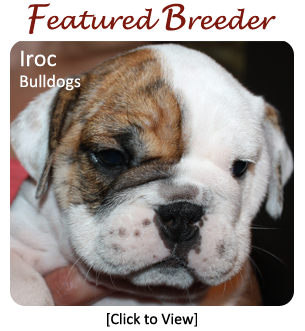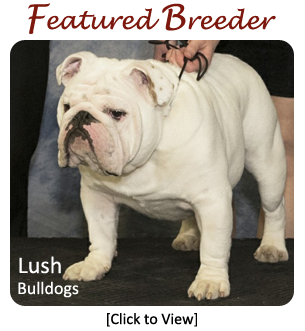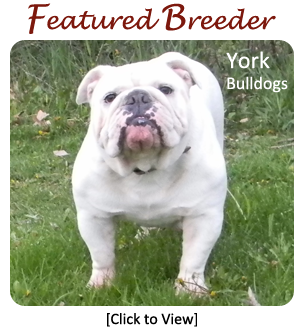
English Bulldog
Group: Non-Sporting Group
Origin: Great Britain
Height: 12 to 16 inches
Weight: 50 to 60 lbs
Commonly Referred to as:
– Bulldog
– English Bulldog
– British Bulldog
CLICK HERE to View Breeder Listings
Breed Profile
The Bulldog is believed to have evolved from the Molossian dog first brought to Britain by Phoenician traders in the 6th century BC. Because of their courage and apparent ability to endure pain, the breed was exploited in the sports of bull baiting, bear baiting and dog fighting. When bull baiting was made illegal in England in 1835 and eventually dog fighting was prohibited, the breed began to decline in numbers. Fortunately, with the beginning of the dog show era, the breed was saved by a group of fanciers determined to preserve the characteristics of the breed and eliminate all fighting and viciousness.
Though the Bulldog may appear to be oddly built, each point of his structure was bred into the breed to aid or protect him while attempting to overcome a bull. His general appearance is one of stability, vigor and strength.
The Bulldog is calm and dignified with a steady, even disposition. He is resolute and courageous but not vicious or aggressive. He loves people and though his appearance may be somewhat intimidating, he does not generally make a good watch dog. He has a relatively low activity level so adjusts well in just about any environment. His facial structure makes him susceptible to snuffling, snorting and snoring.
Today, Bulldogs are successfully competing in Obedience as well as Agility and Tracking, and their calm disposition makes them ideal candidates to work as Therapy Dogs.
For Bulldog coat colours, the Canadian Kennel Club and American Kennel Club Breed Standards state:
“The colour of coat should be uniform, pure of its kind and brilliant. The various colours found in the breed are to be preferred in the following order:
(a) red brindle;
(b) all other brindles;
(c) solid white;
(d) solid red, fawn, or fallow;
(e) piebald;
(f) inferior qualities of all the foregoing.
Note A perfect piebald is preferable to a muddy brindle or defective solid colour. Solid black is very undesirable, but not so objectionable if occurring to a moderate degree in piebald patches. The brindles, to be perfect, should have a fine, even and equal distribution of the composite colours. In brindles and solid colours a small white patch on the chest is not considered detrimental. In piebalds the colour patches should be well defined, of pure colour and symmetrically distributed.”
Additional Information on Coat Colors:
- Coat Color Chart for the Bulldog — from Bulldogs World
Health Issues
The average life expectancy for the Bulldog is from 8 to 12 years; however, some have lived to 15, 16, and even 18 years of age. Like all breeds, the Bulldog is no exception to health related issues, such as:
- Elongated Soft Palate — This is the most common breathing disorder.
- Hypoplastic (narrow) Trachea — The most common signs of a narrow trachea are shortness of breath, gurgling sounds, and/or wheezing. Many Bulldogs live long and happy lives with this condition provided that they are carefully monitored.
- Pinched Nares (nostrils) — With this condition, the dog’s nares are pinched tight causing insufficient air to pass through the nose. This can usually be corrected with surgery.
If you are considering the adoption of a Bulldog puppy, or any breed, it is very important to be selective in choosing a responsible and reputable breeder. Ensure that the prospective puppy’s parents have all health clearances. Breeding of any dog should not be done until after they have been proven to be free of evidence of significant hereditary diseases. (For more information on selecting a breeder, see the articles on the General Information page.)
Recommended Health Screening:
For the Bulldog, the CHICNote 1 database includes health screenings for:
- Patellar Luxation
- Congenital Cardiac Database
- Tracheal Hypoplasia
- Also listed as “optional”: Eye Examination by a board Ophthalmologist (after 24 months of age); Hip Dysplasia; Elbow Dysplasia; Autoimmune Thyroiditis; Congenital Deafness; and Hyperuricosuria
Additional Health Resources:
- Common Bulldog Health Problems
- Heat Stroke/Exhaustion in Bulldogs
- Canine Inherited Disorders Database — Bulldog
- Health and Nutrition — Growing section of the Canada’s Guide to Dogs website which includes information on several health and nutrition related issues.
- Canine Health Information Center (CHIC) – Bulldog Recommended Health Screening — Providing a source of health information for owners, breeders, and scientists that will assist in breeding healthy dogs. CHIC is a centralized canine health database jointly sponsored by the AKC/Canine Health Foundation (AKC/CHF) and the Orthopedic Foundation for Animals (OFA).
- AKC Canine Health Foundation — Working towards developing scientific advances in canine health.
- OFA – Companion Animal Eye Registry (CAER)
- Orthopedic Foundation for Animals (OFA)
- Ontario Veterinary College (OVC)
- University of Pennsylvania Hip Improvement Program (PennHip)
- HealthGene — HealthGene Corporation is the leading provider of veterinary DNA diagnostic services in Canada.
- Labgenvet — Laboratory of Veterinary Genetics is a Canadian diagnostic laboratory that offers a comprehensive service of DNA tests for veterinary genetic diseases.
Breed Standards
- CKC Breed Standard
- AKC Breed Standard
- An Illustrated Guide to the Official Standard of the Bulldog — Published by the Bulldog Club of America
- UKC Breed Standard for the English Bulldog
- The Kennel Club (U.K.) Breed Standard
- FCI Breed Standard No. 149
Grooming Information
- Grooming — This section of the Canada’s Guide to Dogs website includes tips, articles and information covering all aspects of dog grooming along with a listing of Groomers from across Canada.
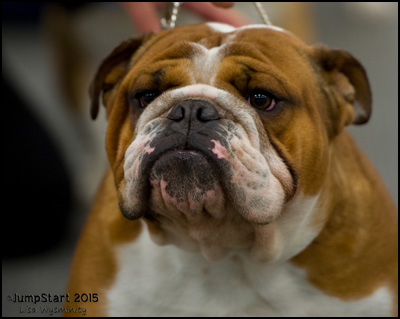
BISS Am. Ch. Grand Can Ch. IROC Viva Las Vegas – “Vinny”
Photo ©Jumpstart 2015, Lisa Wysminity
Courtesy of: Iroc Bulldogs
Training Resources
- Training — For training information, see this growing section of the Canada’s Guide to Dogs website for tips, articles, as well as listings of training centres across Canada.
Additional Information
- Puppy Buyer Beware — By Cindy Madill, BCCC
- What About Mini-Bulldogs?
- Bulldogs World — Excellent Bulldog information web site.
- Clubs, Sports & Activities — For information on the many sports and activities you can get involved in with your dog.
- Working Dogs — The Working Dogs section of the Canada’s Guide to Dogs website provides information and listings of organizations that are involved in various dog jobs, such as Guide Dogs, Therapy Dogs, Police Dogs, Protection Dogs, and much more.
*NOTE 1: CHIC – The Canine Health Information Center “is a database of consolidated health screening results from multiple sources. Co-sponsored by the Orthopedic Foundation for Animals (OFA) and the American Kennel Club (AKC) Canine Health Foundation, CHIC works with parent clubs to identify health screening protocols appropriate for individual breeds. Dogs tested in accordance with the parent club established requirements, that have their results registered and made available in the public domain are issued CHIC numbers.” To learn more, visit: www.caninehealthinfo.org
*NOTE 2: The Fédération Cynologique International (FCI) is the World Canine Organization, which includes 91 members and contract partners (one member per country) that each issue their own pedigrees and train their own judges. The FCI recognizes 344 breeds, with each being the “property” of a specific country. The “owner” countries write the standards of these breeds in co-operation with the Standards and Scientific Commissions of the FCI, and the translation and updating are carried out by the FCI. The FCI is not a breed registry nor does it issue pedigrees.
Breed Listing
Quick Links
Get In Touch
- Email: canadasguidetodogs@gmail.com
- Email: info@canadasguidetodogs.com
- Visit us on Facebook: www.facebook.com/CanadasGuideToDogs
— CanadasGuideToDogs.com is an Amazon Associate as well as a participant in various affiliate programs, as such fees are earned from qualifying purchases.
